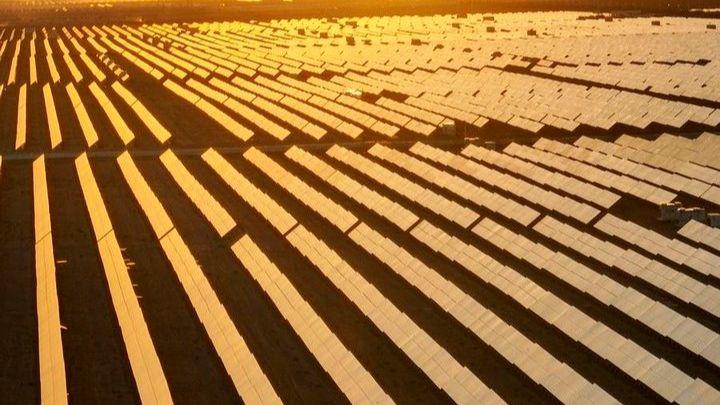
This aerial drone photo taken on Sept. 8, 2024 shows a photovoltaic industrial park in Hami, northwest China's Xinjiang Uygur Autonomous Region. (Xinhua/Hu Huhu)
BEIJING, Oct. 11 (Xinhua) -- China saw a booming photovoltaic (PV) industry in the first six months of this year. During the period, the country's output of polycrystalline silicon, silicon wafers, cells and modules all increased by over 30 percent year on year, and the export of PV modules grew by nearly 20 percent year on year, reported People's Daily Overseas Edition on Wednesday.
China has built complete industrial chains for the R&D, design, and integrated manufacturing of solar PV equipment. The high conversion efficiency of crystalline silicon/perovskite PV cell technology has established multiple world bests, and the conversion efficiency of advanced crystalline silicon PV cells in mass production has exceeded 25 percent, according to a white paper on China's energy transition released by the State Council in August.
-- World-leading output and capacity
In the first half of this year, the output of the major segments in China's PV industrial chain all achieved significant growth.
The PV industrial chain includes upstream, midstream and downstream sectors. The upstream sector encompasses the production and supply of polycrystalline silicon material, which is mainly used to produce silicon wafers and cells. The midstream sector covers the production of cells and PV modules, and the downstream involves the construction of PV power plants, the installation of distributed PV systems and grid connection, said Liu Yiyang, deputy secretary-general of the China Photovoltaic Industry Association (CPIA).
The publicized information of PV enterprises and the estimation of CPIA showed that during the January-June period, China's output of polycrystalline silicon was 1.06 million tonnes, surging 74.9 percent year on year. The output of silicon wafers, crystalline silicon cells, and crystalline silicon modules grew by 58.6 percent, 38.1 percent and 32.8 percent year on year respectively. At the export side, China's export of silicon wafers registered 38.3GW, and that of PV modules went up 19.7 percent year on year to reach 129.2GW.
Meanwhile, the expanding PV application market in the downstream has provided opportunities for more production of PV products. "Driven by the growing demand for renewables globally, the market demand for PV power generation systems is also swelling," Liu mentioned.
China installed 102.48 GW of new PV capacity in the first half, including 49.6GW of centralized PV systems, 37.03GW of business installations, and 15.85GW of household installations, according to data from the National Energy Administration (NEA).
"China has so far made remarkable achievements in many PV segments such as PV cells, modules and silicon wafers," said Liu, adding that thanks to unswerving technological innovation, independent R&D, improvement of production efficiency and other measures by Chinese enterprises, China has become a global leader in terms of PV output and production capacity.
-- Corporate innovation
In 2023, all the top ten solar cell enterprises in the world were from China, whose total production capacity hit 681.2GW, accounting for 66 percent of the world's total, according to Liu Yiyang.
China's PV industry once relied heavily on imported raw materials, equipment and overseas market.
In July 2013, the State Council issued opinions on promoting the sound development of PV industry, explicitly proposing to expand domestic market, improve technological level and accelerate industrial transformation and upgrading to propel the sound and sustainable growth of the PV industry. Under policies that supported development of PV demonstration projects and encouraged the use of solar power to produce electricity for people who lacked access to power, domestic PV installation began showing growth momentum.
As the market expands, enterprises are motivated to step up efforts to carry out technological innovation and independent R&D, which are ways recognized by the industry to produce quality products and establish a foothold in the market.
Taking polycrystalline silicon production as an example, there are two major technological paths: one is improved Siemens process for rod-shaped silicon and the other one is silane fluidized bed method for granular silicon. Compared with rod-shaped silicon, granular silicon has advantages in terms of product quality and reduction in carbon dioxide emissions. After years of technique innovation and technological R&D, Chinese solar power giant GCL Technology (03800.HK) took the lead to realize 10,000-tonne-level mass production of granular silicon in 2021.
Liu Yiyang noted that as Chinese PV enterprises keep scaling up technological R&D efforts to achieve the dual carbon goals, new battery technologies such as perovskite solar cells are emerging, and high-efficiency cell technologies like PERC, TOPCon and HJT are seeing commercialized application.
-- Global layout
China is actively getting integrated into the global clean energy industrial chain, and sharing high-quality clean energy products with the world, said Zhang Jianhua, head of the NEA.
The International Energy Agency (IEA) said last year that it saw a step change in renewable capacity additions, driven by China's solar PV market. In 2023, China commissioned as much solar PV as the entire world did in 2022.
Over the past decade, China has provided premium clean energy products and services to the international market. The country has also doubled its efforts in technological innovation to upgrade new energy technology at a faster pace, contributing enormously to a sharp reduction in the costs of wind power and PV power worldwide, the white paper on China's energy transition told.
Through expanding opening up and cooperation, China has worked with more than 100 countries and regions on green energy projects. In 2023, China's exports of wind power and PV products helped other countries reduce carbon dioxide emissions by about 810 million tonnes, according to the white paper.
Some Chinese PV companies are seeking new growth engines by expanding their global presence. For instance, since the beginning of this year, GCL Technology, Trina Solar Co., Ltd. (688599.SH), and Jinko Solar Co., Ltd. (688223.SH) all announced the launch of PV projects in the Middle East.
(Edited by Su Dan with Xinhua Silk Road, sudan@xinhua.org)




 A single purchase
A single purchase









